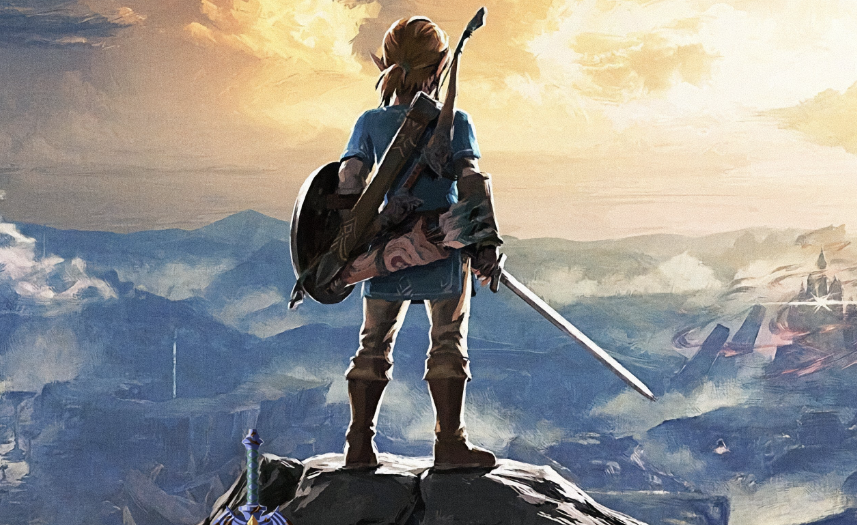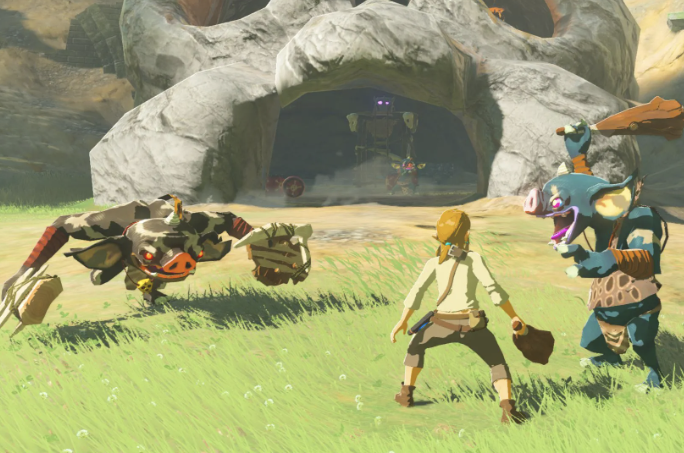The Legend of Zelda Breath of the Wild WIIU
The Zelda saga has numerous years of life behind it, but few games could mark the industry as much and generate as much expectation and illusion as the games of the great saga. The Legend of Zelda: Breath of the Wild does not disappoint. It meets and exceeds all expectations and is a milestone in video gaming history.

Breath of the Wild gives the player an experience that can surprise even the most adept in the industry due to the numerous details characteristic of the Zelda saga. It has unique characteristics that are memorable and distinguishable as a whole. It is not only a combination of combat and exploration mechanics but all of this combined with the mood of the saga, which is already unique in and of itself.
There have been discussions about utilizing Dark Souls’ combat, Far Cry 3’s environment, Assassin’s Creed’s watchtowers, The Phantom Pain’s stealth, and the Xenoblade Chronicles’ scale and sense of wonder.
The animation, enjoyment, and expressiveness of The Wind Waker ride, the details, the notes in the Phantom Hourglass map, the use and collection of Skyward Sword scenario, the half-broken world, the dungeons, their objective in Majora’s Mask, the flexibility of choice of path in A Link Between Worlds, the unavoidable legacy of Ocarina of Time and its twisted core, are just a few examples of small but well-used video game revolutions.
Even when considering Mr. Miyamoto’s original aim, who was seeking that interaction between people to share rumors, findings, and secrets in the light of how sparse the game has been in explanations, the feeling and demand of adventure and loneliness of the first The Legend of Zelda for NES is unquestionably a fascinating thing.

You could list elements that make Breath of the Wild such an odd combination of ideas forever, especially if the guide included spoilers, all of which do not matter when it comes to playing the actual game when Link awakens on the Plateau of Dawn and is immediately given the mission of defeating Ganon. Everything you can accomplish in this enormous Hyrule, whether ridiculous or epic, improves the odds of victory.
Breath of the Wild informs you that it is inconceivable that you can genuinely walk right to the final boss before going through the conventional approaches of dungeons and towns.
The universe is entirely open from the start, allowing players to choose how they will confront the final battle, whether it be after five hours, fifty hours, whether it’s with all the assistance the player can get by finding the most classic format of Zelda, regardless of the number of hearts, whether it’s with Master Sword or with a tree branch, or whether it’s with an investigation into what happened or simply because your mission requires it.
And this independence is at the heart of the game’s design. Whether in the entirety of Zelda, a repeating differentiating mechanic exists, like traveling between seasons or through time, becoming a wolf and changing shape, sailing, shrinking in size, becoming a wall painting, or flying, the Breath of Wild’s critical action is undoubtedly climbing.
The mechanism is as easy as sticking to the wall and climbing as far as your stamina allows and can generate a lot of satisfaction when you can tell when or where to climb. This simple mechanism raises the depth of the game and makes it unique at the same time.
The price of this freedom is that details are lost and gained depending on who the player compares themselves to. The narrative in Breath of Life shines because it can deconstruct a straightforward plot and give it infinite layers that add up. Conversations with NPC can help the player learn more about a place that might initially seem hostile and alien.

Reading the pages of a diary can give the player more data about the plot than the game’s nonplayable sequences. Additionally, the discovered plot is not fixed and has no significant relevance to the player’s final mission. This serves absolute freedom that can overwhelm you even after hours of control.
There is also a different Link that helps show how innovative Breath of the Wind is in the chronicle, a Link that must change weapons constantly to adapt to the enemy and situation, with an endless inventory of collected objects that have diverse uses and do not obey or follow preestablished paths that are limited by barriers.
The link is familiar, yet simultaneously not anything like the saga’s protocols. It is skilled in horse riding, fencing, puzzle solving, witty silent answers, and archery.
And most critics are aware that nothing they have to say about The Legend of Zelda: Breath of the Wild can compare to the first time they started exploring and experienced both the joy and the dread of the undiscovered. They feel like they still have much to explore after over 80 hours of gameplay, regardless of having at least flown across the whole map.
Everything is vibrant; the player flits from one goal to another, talking to people who provide them with information about local legends, finding a shrine to visit to solve a problem and boost their life or stamina.
Still, occasionally, they come across an oddly shaped group of stones, silhouettes that disturb even the mildest OCD, sunken treasures in small swamps, or groups of enemies defending valuable loot.
These things happen while they collect flowers and mushrooms, go hunting, and choose between fleeing or fighting those menacing mechanical Guardians’ intimidating presence or straying since that small cluster of islands looks so appealing.
Or, just as they watch the awesome animations of the waving blades of grass, which gives them the impression that they are in a dream, the journey never ends with all the letters.
If you focus more on technology and disregard the technique, there are unavoidably certain faults. But in all honesty, fans don’t think the framerate fluctuations that don’t impair the gameplay are a good enough excuse to take away the 10.
It might be the absence of ‘dungeons’ to access in other Zelda or the simplicity of several final bosses, enemies with too much stamina that blur the ‘boss’ concept. Still, again, you would be required to consider your comparisons.
Additionally, The Legend of Zelda: Breath of the Wild cannot be contrasted with previous titles from the same series and does not attempt to be compared to other open-world games and the list named above.
The problematic aspect is trying to imagine how, after Breath of the Wild, you can return to Zelda “from before” or how they will improve something already astounding. The good news is that, unlike after Ocarina of Time, when they continued to produce Zelda 2D, the previous iteration’s “classic style,” this one does not try to keep the term from becoming obsolete.
It is worth mentioning that Breath of the Wild is a highly demanding game, significantly challenging, a far cry from that aspect of the organization that accommodates all kinds of players, regardless of how novice they are.
In any case, the classic style will continue to be necessary for Zelda to progress with Nintendo’s “consumer-friendly” outlook. But who knows, perhaps it will act as a fresh beginning for tomorrow, so today’s kids can say, “back in my youth, there were harder games.” Or perhaps video games will start to value the player more.
Even considering all of this distinctiveness, it still maintains that unique and compelling point for fans, with its intriguing conversations, eccentric characters, perfect puzzles, and, of course, its soundtrack, which fully understands how or when to stand out for its nuance all through the adventure, but it also recognizes what to do to implore and disperse the rhythm in minigames, populations, combats, tests, and also knows what to do to amuse while in a whole final phase of órdago completely.
This review was not intended just to be a series of compliments, so it won’t give you a technical rundown of the game or delve into the minute aspects of its story or the countless hidden mysteries and delights that Breath of the Wild has.
The changes between day, afternoon, and night, as well as how the temperature and weather affect not only the combat but also the exploration, would not make the world’s wonders feel as alive, and it is preferred not to return to the endless opportunities of trying to pass through areas or escaping difficulties in a predicament.
Popular examples include metallic objects able to attract lightning in a storm or climbing that slips in the rain, as well as numerous others that are less well known, like the truth that explosive arrows will not work when it is raining and will explode in the player’s hands in areas of extreme heat, that food changes depending on the player’s environment, or that there are other ways to deal with the cold besides wearing warm clothing or eating spicy food, like lighting a torch or using certain weapons.
The volume of a substance in The Legend of Zelda: Breath of the Wild is so extensive that it would be impossible to finish everything in a single lifetime due to the depth of intricacy put into the game. And even though critics have played video games their entire life, they can only think of a handful that has ever surprised, hooked, and amazed them as much as Breath of the Wild.
It might not be among the games that fundamentally change a field, but it advances it. It might not be the level comparable to Super Mario 64, but it might be the Half-Life of first-person shooters. As other great sagas have done in recent years in search of fresh ideas, Breath of the Wild is not just a new way to recycle and show an epic with thirty years of history.
Breath of the Wild is the best and most innovative approach to depicting an open world that has earned the moniker. As extravagant as it may sound, it is a complete revolution and one of those that merits inclusion in the hall of fame of the greatest video games in our little but passionate history.